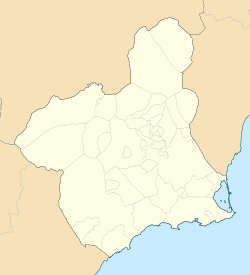Cueva Antón
38°3′51.84″N 1°29′47.20″W / 38.0644000°N 1.4964444°W
Cueva Antón | |
| Location | Mula basin |
|---|---|
| Site notes | |
| Archaeologists | João Zilhão |
Cueva Antón is a paleoanthropological and archeological site in the Region of Murcia of southeast Spain. The cave is located about 60 kilometers from the Mediterranean port city of Cartagena inland in the territory of the municipality of Mula. It was eroded by the Río Mula and served as a cave in the Middle Palaeolithic inhabited by Neanderthals. The cave became internationally known in 2010, after a shell at least 43,000 years old with adhering orange pigment was discovered there. The pigment found was interpreted as evidence that the shell was used "in an aesthetic and probably symbolic" way. The find from the Cueva Antón was published together with similar finds from the Cave of Los Aviones; they were named as the first such Neanderthal jewelry found in Europe. The colonization of the Iberian Peninsula by modern man ( Homo sapiens ) took place only several thousand years after the creation of the jewelry from the Cueva Antón.[1][2] This site is the last known place where Neanderthal people resided.[3]
The rock of the cave is Eocene limestone. It is at the base of a 25 meter high cliff on the bank of the Río Mula. The base of the cave was filled with four meters of sediment.
References
- ^ Zilhao, J.; Angelucci, D. E.; Badal-Garcia, E.; d'Errico, F.; Daniel, F.; Dayet, L.; Douka, K.; Higham, T. F. G.; Martinez-Sanchez, M. J.; Montes-Bernardez, R.; Murcia-Mascaros, S.; Perez-Sirvent, C.; Roldan-Garcia, C.; Vanhaeren, M.; Villaverde, V.; Wood, R.; Zapata, J. (11 January 2010). "Symbolic use of marine shells and mineral pigments by Iberian Neandertals". Proceedings of the National Academy of Sciences. 107 (3): 1023–1028. doi:10.1073/pnas.0914088107. PMC 2824307. PMID 20080653.
- ^ Balter, M. (14 January 2010). "Neandertal Jewelry Shows Their Symbolic Smarts". Science. 327 (5963): 255–256. doi:10.1126/science.327.5963.255.
- ^ Zilhão, João; Anesin, Daniela; Aubry, Thierry; Badal, Ernestina; Cabanes, Dan; Kehl, Martin; Klasen, Nicole; Lucena, Armando; Martín-Lerma, Ignacio; Martínez, Susana; Matias, Henrique; Susini, Davide; Steier, Peter; Wild, Eva Maria; Angelucci, Diego E.; Villaverde, Valentín; Zapata, Josefina (November 2017). "Precise dating of the Middle-to-Upper Paleolithic transition in Murcia (Spain) supports late Neandertal persistence in Iberia". Heliyon. 3 (11): e00435. doi:10.1016/j.heliyon.2017.e00435. PMC 5696381. PMID 29188235.
{{cite journal}}: CS1 maint: unflagged free DOI (link)


